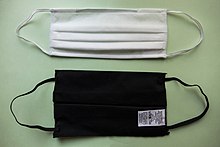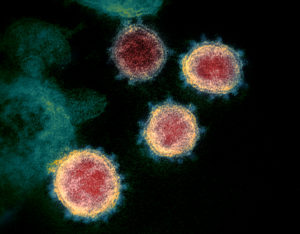 Today while waiting in a line at the store, everyone wearing the required masks, the woman in front of me told me that the masks are useless and that there isn't good evidence that the coronavirus is spread through the air. Huh? Where did she get that idea? Of course there is airborne transmission of the virus!
Today while waiting in a line at the store, everyone wearing the required masks, the woman in front of me told me that the masks are useless and that there isn't good evidence that the coronavirus is spread through the air. Huh? Where did she get that idea? Of course there is airborne transmission of the virus!
It's true that some government agencies are hedging about airborne transmission of SARS-CoV-2 (the virus which leads to COVID-19 infection) , but the scientific evidence for aerosol and droplet transmission of the virus is growing and very clear. [Aerosols are smaller than droplets, and both carry the virus.] Fortunately, the evidence just isn't there for getting this particular virus from touching surfaces (such as doorknobs or faucets) - which originally was a big worry.
The following are some articles that discuss how airborne transmission occurs, why wearing a mask protects us from others exhaling the virus, and also protects us from inhaling the virus and lowers how much virus we are exposed to (cloth and surgical masks protect us from most virus particles, but not all). In fact, some scientists are wondering whether wearing masks so lowers the amount of virus a person is exposed to (viral load), that if a person gets the infection, the body can deal with it much better and the infections may be asymptomatic or minor.
 In case you're wondering: being outdoors dilutes and disperses the virus. If you are concerned about the virus spreading indoors - then open a window (to dilute and disperse the virus).
In case you're wondering: being outdoors dilutes and disperses the virus. If you are concerned about the virus spreading indoors - then open a window (to dilute and disperse the virus).
This is a really big deal - the possibility that up to 95% of infections could be asymptomatic! Excerpts from an interesting article by Dr. Monica Gandhi (Prof. of Medicine at Univ. of California) at The Conversation: Cloth masks do protect the wearer – breathing in less coronavirus means you get less sick
It seems people get less sick if they wear a mask.
When you wear a mask – even a cloth mask – you typically are exposed to a lower dose of the coronavirus than if you didn’t. Both recent experiments in animal models using coronavirus and nearly a hundred years of viral research show that lower viral doses usually means less severe disease.
In July, the CDC estimated that around 40% of people infected with SARS-CoV-2 are asymptomatic, and a number of other studies have confirmed this number.
However, in places where everyone wears masks, the rate of asymptomatic infection seems to be much higher. In an outbreak on an Australian cruise ship called the Greg Mortimer in late March, the passengers were all given surgical masks and the staff were given N95 masks after the first case of COVID-19 was identified. Mask usage was apparently very high, and even though 128 of the 217 passengers and staff eventually tested positive for the coronavirus, 81% of the infected people remained asymptomatic.
Further evidence has come from two more recent outbreaks, the first at a seafood processing plant in Oregon and the second at a chicken processing plant in Arkansas. In both places, the workers were provided masks and required to wear them at all times. In the outbreaks from both plants, nearly 95% of infected people were asymptomatic.
Very nice article about how aerosol droplets spread through the air, steps we can take, how the aerosol droplets are diluted outdoors, etc. Written by Dr. Jose-Jimenez (Univ. of Colorado), from Time: COVID-19 Is Transmitted Through Aerosols. We Have Enough Evidence, Now It Is Time to Act
When it comes to COVID-19, the evidence overwhelmingly supports aerosol transmission, and there are no strong arguments against it.
Talking, and especially singing and shouting increase aerosol exhalation by factors of 10 and 50, respectively. Indeed, we are finding that outbreaks often occur when people gather in crowded, insufficiently ventilated indoor spaces, such as singing at karaoke parties, cheering at clubs, having conversations in bars, and exercising in gyms. Superspreading events, where one person infects many, occur almost exclusively in indoor locations and are driving the pandemic. These observations are easily explained by aerosols, and are very difficult or impossible to explain by droplets or fomites.
From a July article in Nature: Mounting evidence suggests coronavirus is airborne — but health advice has not caught up
Converging lines of evidence indicate that SARS-CoV-2, the coronavirus responsible for the COVID-19 pandemic, can pass from person to person in tiny droplets called aerosols that waft through the air and accumulate over time. After months of debate about whether people can transmit the virus through exhaled air, there is growing concern among scientists about this transmission route.
For those who want to hear in-depth information - a Sept. 10, 2020 Harvard Medicine Grand Rounds lecture (Harvard Medical School) featuring Dr. Anthony Fauci speaking about COVID-19, including other coronaviruses. Includes lots of illustrations, graphs, and him saying: "Bottom line is, there's much more aerosol [transmission] than we thought." (One hour 6 minutes long.)
